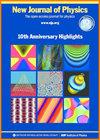控制多体量子混沌:玻色-哈伯德系统
IF 2.8
2区 物理与天体物理
Q2 PHYSICS, MULTIDISCIPLINARY
引用次数: 0
摘要
这项工作针对困在光学晶格中的超冷玻色气体,开发了多体量子混沌的量子控制应用。在经典混沌系统中,如何利用对初始条件变化的指数敏感性来达到控制目的早已众所周知。在这种被称为 "瞄准 "的技术中,不稳定性不再是控制的障碍,而是一种资源。最近,通过周期性地抵消不可避免的量子态扩散或引入控制哈密顿,这种经典的瞄准技术被推广到量子系统中,两者都能使局部状态沿着特殊的混沌轨迹被引导到各种所需的目标状态。其中只涉及严格的单元动力学;也就是说,它给出了一种相干的量子目标定位。本文将控制哈密顿的引入应用于混沌动力学状态下的玻色-哈伯德系统。经过适当选择的不稳定均值场解可以特别快速地跟踪到具有精确相位关系和占位关系的状态。从本质上讲,该方法产生了一种量子模拟技术,可以进入相当特殊的状态。该方案简化为化学势的时间控制,为应用于光学晶格实验提供了可能性。在一维和二维晶格(三维应用也同样可能)中介绍了量子多体痕的定制状态制备和稳定的明确应用。本文章由计算机程序翻译,如有差异,请以英文原文为准。
Controlling many-body quantum chaos: Bose–Hubbard systems
This work develops a quantum control application of many-body quantum chaos for ultracold bosonic gases trapped in optical lattices. It is long known how to harness exponential sensitivity to changes in initial conditions for control purposes in classically chaotic systems. In the technique known as targeting, instead of a hindrance to control, the instability becomes a resource. Recently, this classical targeting has been generalized to quantum systems either by periodically countering the inevitable quantum state spreading or by introducing a control Hamiltonian, where both enable localized states to be guided along special chaotic trajectories toward any of a broad variety of desired target states. Only strictly unitary dynamics are involved; i.e. it gives a coherent quantum targeting. In this paper, the introduction of a control Hamiltonian is applied to Bose–Hubbard systems in chaotic dynamical regimes. Properly selected unstable mean field solutions can be followed particularly rapidly to states possessing precise phase relationships and occupancies. In essence, the method generates a quantum simulation technique that can access rather special states. The protocol reduces to a time-dependent control of the chemical potentials, opening up the possibility for application in optical lattice experiments. Explicit applications to custom state preparation and stabilization of quantum many-body scars are presented in one- and two-dimensional lattices (three-dimensional applications are similarly possible).
求助全文
通过发布文献求助,成功后即可免费获取论文全文。
去求助
来源期刊

New Journal of Physics
物理-物理:综合
CiteScore
6.20
自引率
3.00%
发文量
504
审稿时长
3.1 months
期刊介绍:
New Journal of Physics publishes across the whole of physics, encompassing pure, applied, theoretical and experimental research, as well as interdisciplinary topics where physics forms the central theme. All content is permanently free to read and the journal is funded by an article publication charge.
 求助内容:
求助内容: 应助结果提醒方式:
应助结果提醒方式:


